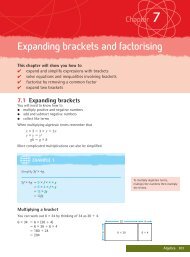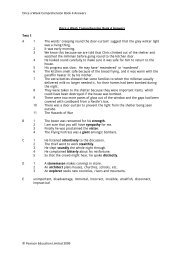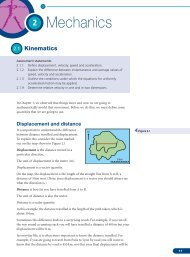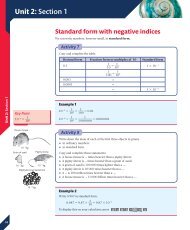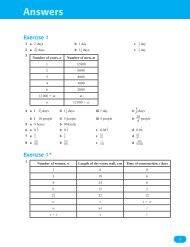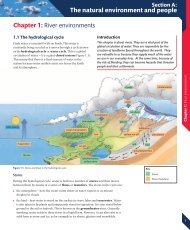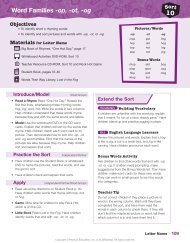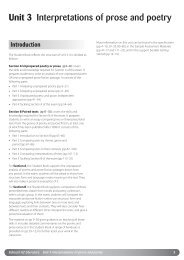Chapter 1: Hardware - Pearson Schools
Chapter 1: Hardware - Pearson Schools
Chapter 1: Hardware - Pearson Schools
You also want an ePaper? Increase the reach of your titles
YUMPU automatically turns print PDFs into web optimized ePapers that Google loves.
1024 by 768. These screen dots are not the same as picture elements, because some<br />
software packages use picture elements that are much bigger than the tiny screen<br />
dots. For many packages, however, the picture element is as small as the screen dot<br />
– this is the smallest possible size for the pixel.<br />
Graphics cards<br />
The graphics card which is also known as the video card or display card is<br />
housed within the system unit, and controls the signals going to the monitor<br />
screen. Higher-quality cards can produce very clear graphics very quickly. Some<br />
computer games demand advanced display cards and high-quality monitor<br />
screens.<br />
Cathode ray tube (CRT) monitors<br />
Cathode ray tube monitors used to be the commonest type of monitor. CRT<br />
monitors can be relatively bulky (see Figures 1.27 and 1.28).<br />
<strong>Chapter</strong> 1: <strong>Hardware</strong><br />
A perfect box<br />
Liquid crystal display (LCD) monitors<br />
Liquid crystal display technology allows the screen to be flat, instead of bulky as<br />
with CRT monitors. LCD screens consume less power than CRT displays. An LCD<br />
screen is generally more compact than a corresponding CRT display (see Figures<br />
1.27 and 1.28).<br />
LCD monitor screens vary considerably in size and resolution. For example, a<br />
typical 15-inch screen might have a resolution of 1024 × 768 pixels and a 30-inch<br />
screen 2560 × 1600. Higher-quality screens have more pixels per inch. Small<br />
screens built into PDAs and smart phones are likely to have a lower quality display<br />
with fewer pixels per inch.<br />
LCD screen technology is currently the most popular for use with PCs. However,<br />
there are other alternatives; for example, plasma displays (which are clear and<br />
bright) and electroluminescent displays (which have the potential to support very<br />
large flexible displays).<br />
Close-up view of the top right corner,<br />
showing the picture elements (pixels)<br />
Figure 1.26 Picture elements<br />
Touch screens<br />
A touch screen is not just an output device; it is a two-way user interface. You<br />
can interact with the computer by touching pictures or words on the screen. Touch<br />
screens are widely used with tablet PCs, PDAs and Smart Phones. There are<br />
different touch screen technologies. For example, the iPhone uses a capacitive<br />
touch screen. This is glass panel with a layer that stores electrical charge on it<br />
facing outwards. When you touch the screen, you conduct some of the electrical<br />
charge, reducing it at that point. The iPhone knows where you touched the screen<br />
because it knows where the charge was reduced. This is why the iPhone works best<br />
if you use your finger to operate it. Resistive screens often work best with a stylus<br />
because they work by detecting changes in the electrical charge when internal<br />
charged and conductive layers are pressed together.<br />
16








